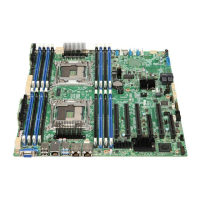Intel® Server Board S2600CW Functional Architecture Intel® Server Board S2600CW Family TPS
28 Revision 2.4
Mixing of DDR4 operating frequencies is not validated within a socket or across sockets
by Intel. If DIMMs with different frequencies are mixed, all DIMMs will run at the
common lowest frequency.
A maximum of 8 logical ranks (ranks seen by the host) per channel is allowed.
DIMMs with different timing parameters can be installed on different slots within the
same channel, but only timings that support the slowest DIMM will be applied to all. As
a consequence, faster DIMMs will be operated at timings supported by the slowest
DIMM populated.
When one DIMM is used, it must be populated in the BLUE DIMM slot (farthest away
from the CPU) of a given channel.
When single-, dual-, and quad-rank DIMMs are populated for 2DPC, always populate
the higher number rank DIMM first (starting from the farthest slot), for example, first
quad-rank, then dual-rank, and last single-rank DIMM.
3.3.3 Effects of Memory Configuration on Memory Sizing
The system BIOS supports 4 memory configurations – Independent Channel Mode (Maximum
Performance mode) and 3 different RAS Modes. In some modes, memory reserved for RAS
functions reduce the amount of memory available.
Independent Channel mode: In Independent Channel Mode, the amount of installed
physical memory is the amount of effective memory available. There is no reduction.
Independent Channel mode is also known as Maximum Performance mode.
Lockstep Mode: For Lockstep Mode, the amount of installed physical memory is the
amount of effective memory available. There is no reduction. Lockstep Mode only
changes the addressing to address two channels in parallel.
Rank Sparing Mode: In Rank Sparing mode, the largest rank on each channel is
reserved as a spare rank for that channel. This reduces the available memory size by
the sum of the sizes of the reserved ranks.
Example: If a system has two 16GB Quad Rank DIMMs on each of 4 channels on each of
2 processor sockets, the total installed memory will be (((2 * 16GB) * 4 channels) * 2
CPU sockets) = 256GB.
For a 16GB QR DIMM, each rank would be 4GB. With one rank reserved on each
channel, that would 32GB reserved. So the available effective memory size would be
256GB - 32GB, or 224GB.
Mirroring Mode: Mirroring creates a duplicate image of the memory that is in use,
which uses half of the available memory to mirror the other half. This reduces the
available memory size to half of the installed physical memory.
Example: If a system has two 16GB Quad Rank DIMMs on each of 4 channels on each of
2 processor sockets, the total installed memory will be (((2 * 16GB) * 4 channels) * 2
CPU sockets) = 256GB.
In Mirroring Mode, since half of the memory is reserved as a mirror image, the available
memory size would be 128GB.

